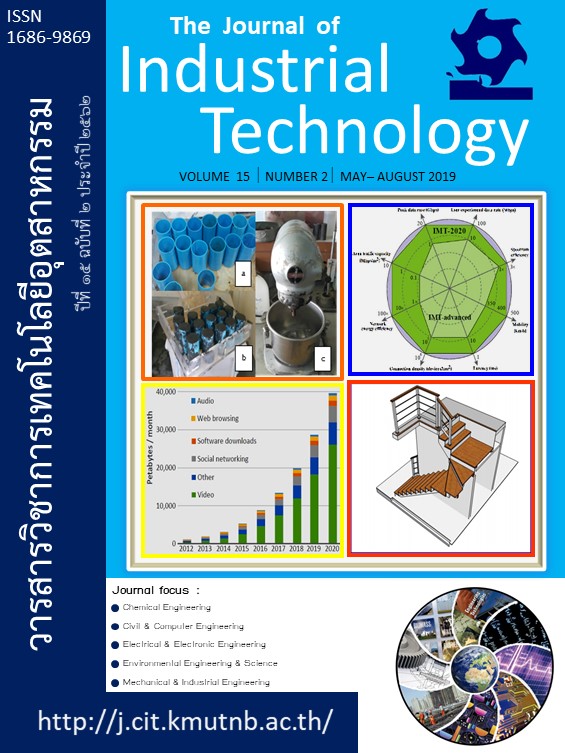การวิเคราะห์ Moderated Mediation Model ด้วยโปรแกรม PROCESS(Moderated Mediation Effect Analysis Through Process Routine)
Keywords:
Conditional Effect, Conditional indirect effect, Moderated mediation modelAbstract
Abstract
Mediator is a hidden variable that transmitted effect of antecedent variable to its outcome. There could be single or multiple mediators in any SEM model. In multiple mediator’s facet, parallel mediation or serial mediation could be addressed through knowledge challenged by expertise or literature. And, if researchers need to know what variables can possibly change the relationship in any or all paths of mediation model, an analysis through moderated mediation model should be addressed.
References
[2] J. Greenberg and R.A. Baron, “Behavior in Organizations: Understanding and Managing the Human Side of Work”, Upper saddle River, NJ: Pearson Prentice Hall, 2008.
[3] F. Scrima, L. Lorito, E. Parry and G. Falgares, “The Mediating Role of Work Engagement on The Relationship Between Job Involvement and Affective Commitment”, The International Journal of Human Resource Management, DOI: 10.1080/09585192.2013.862289, 2013, pp.2159-2173.
[4] B. Xie, X. Lu and W. Zhou, “Does Double Plateau Always Lead to Turnover Intention? Evidence from China with Indigenous Career Plateau Scale”, Journal of Career Development, Reprints and permission: sagepub.com/journals Permissions.navDOI:10.1177/0894845315580642jcd.sagepub.com, 2015, pp.1-14.
[5] M. Padenga, “The Moderation-Mediation Effect of a Stress Mindset on the Relationship between Organizational Justice and Job Outcomes in the UK Service Sector”, A thesis submitted to meet the requirements for the degree of Doctor of Philosophy in Business and Management in the School of Business and Law, University of Salford, Manchester, 2016.
[6] K. Tsai, H. Chang and C. Peng, “Extending the Link Between Entrepreneurial Self-Efficacy and Intention: A Moderated Mediation Model”, International Entrepreneurship and Management Journal 12(2), 2016, p. 445.
[7] A.F. Hayes, “SPSS PROCESS documentation”, Retrieved January 2017, from http://www. marketing- wiwi. uni- jena.de/ wmarmedia/ dokumente/ WS+15_ 16/ DAM/ Process_ Anleitung_ alle_Modelle.pdf, 2013.
[8] R.M. Baron and D.A. Kenny, “The Moderator–Mediator Variable Distinction In Social Psycholo-Gical Research: Conceptual Strategic And Statistical Considerations”, Journal of Personality and Social Psychology 51(6), 1986, pp. 1173-1182.
[9] J. Henseler and W.W. Chin, “A Comparison of Approaches For The Analysis of Interaction Effects Between Latent Variables Using Partial Least Squares Path Modeling”, Structural Equation Modeling 17(1), 2010, pp. 82-109.
[10] J.F. Hair, C.M. Ringle and M. Sarstedt, “Partial Least Squares Structural Equation Modeling: Rigorous Applications Better Results and Higher Acceptance”, Long Range Planning 46(1-2), 2013b, pp. 1-12.
[11] W.W. Chin, “The Partial Least Squares Approach to Structural Equation Modeling In G.A. Marcoulides (ed.) Modern Methods for Business Research”, Mahwah, NJ: Lawrence Erlbaum Associates, 1998, pp. 295-336.
[12] M. Swinarski, R. Kishore and H.R. Rao, “Vendor commitment in an ASP outsourcing context: a com-parative evaluation of the roles of power and partnership”, retrieved March 13, 2018 from https://pdfs.semanticscholar.org/1fe3/9538 caf 253961 a823d2d5ac279bc907a0884.pdf, 2008.
[13] M. Piriyakul, “Mediators and Test of Indirect Effect”, Journal of Management and Development, Ubon Ratchathani Rajabhat University, 2(1), 2015, pp. 11-31. (in Thai)
[14] A.F. Hayes, “An Index and Test of Linear Moderated Mediation”, Multi-variate Behavioral Research 50, 2015, pp.1-22.
[15] T.A. Judge, C.J. Thoresen, J.E. Bono and G.K. Patton, “The Job Satisfaction-Job Performance Relationship: A Qualitative and Quantitative”, Review Psychological Bulletin 127(3), 2001 pp. 376-407.
[16] M. Wetzels, G. Odekerken-Schröder and C.V. Oppen, “Using PLS Path Modeling for Assessing Hierarchical Models: Guidelines and empirical illus-tration”, MIS Quarterly 33(1), 2009, pp. 177-195.


